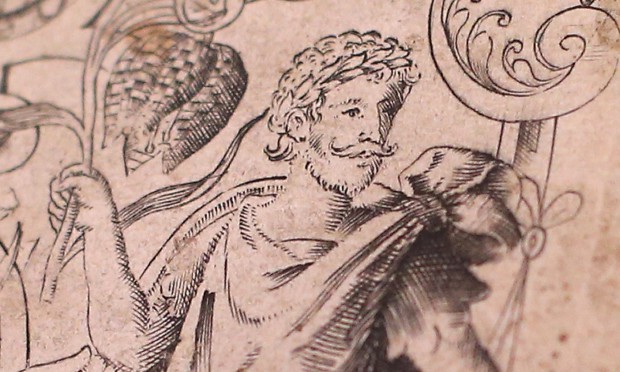In its issue dated 20 May, Country Life has published a long article by the botanical historian Mark Griffiths claiming that a figure on the magnificent title page of John Gerard’s great and prodigally illustrated Herball, of 1587, represents Shakespeare. The magazine also promises, as a follow-up, what it calls a new play by Shakespeare along with fresh information about his early career. In fact the ‘play’, identified in the article, is a really rather boring speech of welcome delivered by a hermit along with a dialogue between a gardener and a molecatcher, both long known to scholars, and both of unknown authorship, which formed part of an entertainment given before Queen Elizabeth I at Theobalds in May 1591.
On each corner of the central part of Gerard’s title page stands one of four figures; Griffiths, in my view correctly (though not everyone agrees), identifies one of them as Gerard himself, portrayed, understandably, as a gardener holding a spade; another as Lord Burleigh, elaborately costumed, for whom Gerard created gardens; and the third as Rembert Dodoens, the Dutch author of the book of 1554 on which Gerard based his work. The fourth figure, dressed in Roman costume and wearing a crown of bays, or laurel wreath, holds in one hand a fritillary – introduced into England only about twenty years before Gerard’s book appeared – and in the other a cob of corn. This is the one whom Griffiths believes to be Shakespeare. His complicated evidence depends partly on the laurel wreath, traditionally a mark of honour for a poet, but principally on a tortuous attempt to decode a device printed below the figure which Griffiths interprets as a rebus, or cipher, made up in part of coded allusions to the coat of arms granted to Shakespeare’s father John in 1596, which appears on William’s monument in Holy Trinity Church, Stratford-upon-Avon. There is however no evidence that either he or his father had used it by the time the book appeared.
This inherently improbable idea has been challenged on Twitter by John Overholt, curator of early modern books and manuscripts at the Houghton Library of Harvard University, who believes that it is in fact a printer’s device, a kind of trademark identifying the publisher. Griffiths has replied to this in a letter to the Daily Telegraph online by suggesting that the eighteenth-century book in which it was identified as a printer’s device is in error, but anyone familiar with such devices is likely to think that it is more likely to be one than an elaborately constructed conundrum, which in any case could be differently interpreted from the way that Griffiths does.
Part of Griffiths’s corroborative evidence relies on the corn and the fritillary which the figure he identifies as Shakespeare is holding and which he links to allusions in Venus and Adonis and Titus Andronicus. But ‘corn’ is a common word in Shakespeare, and the ‘purple flower… chequered with white’ into which Adonis is metamorphosed in the poem, identified by Griffiths as a fritillary – never mentioned by Shakespeare – seems much more likely to be the anemone as it is in Ovid’s version of the story and which Gerard himself describes as the ‘Adonis flower’.
Nevertheless Griffiths’s successful identification of three of the figures on the title page naturally leads to conjecture about whom the fourth represents, even if it is not Shakespeare. The Roman costume can be discounted, I think, because the other three characters are contemporary figures togged up in various forms of fancy dress. The crown of bays suggests a poet, not necessarily a dramatic poet. My guess is that the figure represents Sir Walter Raleigh. He was of course an international traveller and plant importer, famous for the introduction to England of tobacco and the sweet potato. And Griffiths describes sweetcorn as ‘an American crop’. Moreover – and this seems to me the most telling argument that Raleigh is the model for the figure represented here – in 1599 Gerard, I’m informed by Adam Barker, a student at the Shakespeare Institute, dedicated to Raleigh a book about plants called Catalogus arborum, fruticum ac plantarum, a catalogue of trees, fruits and plants.
Griffith’s theories have provoked much disagreement, even derision, among scholars. He was perhaps unwise to announce his conclusions before publishing his evidence. But he has done a service in opening up discussion of a fascinating document which was well worthy of fresh investigation.
Stanley Wells is the author of ‘Great Shakespeare Actors‘ and ‘William Shakespeare: A Very Short Introduction‘, both from OUP





Comments